H2O2 Based Oxidation Processes for the Treatment of Real High Strength Aqueous Wastes
Abstract
:1. Introduction
2. Materials and Methods
2.1. Aqueous Wastes
2.2. Pilot Scale Plants
- Plant A consists of a 2 L glass reactor; the cover is welded and a discharge valve is placed on the bottom. An external jacket connected to a cryostat is used for cooling the system. On the central cone a stirring device is applied. In the lateral cone two medium-high-pressure UV lamps are placed: each lamp has a power of 125 W (emission spectrum: 280–400 nm).
- Plant B consists of AISI 316L stainless steel photo-reactor (8 L volume), containing one UV lamp. During the experimental work, two different kinds of lamp were used: the first is a low-pressure lamp with a power of 36 W (emission spectrum: 254 nm); the second is similar but with a power of 120 W. The following advantages may be ascribed to the use of low-pressure lamps: low surface temperature (40–50 °C), high power conversion efficiency (35%–40% of electric energy is converted into useful UV energy) and long duration (8000–10,000 h).
- Plant C consists of: an AISI 316L stainless steel photo-reactor (10 L volume), a high-pressure UV lamp (power: 10–30 kW; emission spectrum: 200–700 nm), a feeding pump (with flowrate adjustable from 2 to 10 L·min−1), a pump for H2O2 dosage (flowrate adjustable up to 8 mL·min−1), probes for the measurement of flowrate, electrical conductivity, pH, redox potential, and temperature. The UV lamp used in this plant simulates solar radiation.
2.3. Experimental Tests
2.4. Analytical Methods
3. Results and Discussion
3.1. Phase I: COD Removal
3.1.1. H2O2/UV Process
3.1.2. Photo-Fenton Process
3.1.3. Fenton Process
3.2. Phase II: Anionic and Non-Ionic Surfactant Removal
Fenton Process
4. Conclusions
- The H2O2/UV process was very effective, yielding a COD removal efficiency higher than 70% in 120 min reaction, with a dosage of hydrogen peroxide lower than the stoichiometric value (the optimal H2O2/CODinitial dosage ratio being 1/2). The decrease of the UV power caused a significant reduction in the removal of COD, but the radiation intensity (up to 2000 W·L−1 in our experimentation) revealed to be a crucial factor especially in the earlier stage of the process (about for 40 min): this aspect can be exploited to reduce the costs related to energy consumption.
- The results of the photo-Fenton process were comparable to those obtained with the H2O2/UV treatment in terms of COD removal, at a reaction time of 240 min. No significant catalytic effect was observed by the addition of iron (an Fe2+/H2O2 ratio of 1/30 was finally chosen). The specific power input was 125 W·L−1 (medium-high pressure Hg lamp) and the H2O2/CODinitial ratio was 1/2. Photolytic reactions and the presence of dissolved oxygen (activated by UV radiation), either inflated or transferred by strong mixing conditions, revealed to be crucial factors for COD removal, which occurred even after the complete disappearance of hydrogen peroxide.
- The COD removal efficiency obtained with the Fenton process (phase I) was lower than 25%. The organic matter, present at very high concentration, exerted an inhibitory effect on the Fe2+ regeneration process, thus leading to the accumulation of H2O2.
- On the contrary, Fenton oxidation exerted very good performance in the treatment of aqueous wastes with high concentrations of surfactants (phase II). In this case, the results showed that the optimal treatment conditions for surfactants removal are the following: Fe2+/H2O2 = 1/4, H2O2/CODinitial ratio = 1, and contact time = 30 min. These process conditions allowed to obtain an average removal yield of 70% for TAS and 95% for MBAS.
Acknowledgments
Author Contributions
Conflicts of Interest
References
- Collivignarelli, M.C.; Abbà, A.; Bertanza, G. Treatment of high strength pharmaceutical wastewater in a Thermophilic Aerobic Membrane Reactor (TAMR). Water Res. 2014, 63, 190–198. [Google Scholar] [CrossRef] [PubMed]
- Collivignarelli, M.C.; Abbà, A.; Bertanza, G. Why use a Thermophilic Aerobic Membrane Reactor for the treatment of industrial wastewater/liquid waste? Environ. Technol. 2015, 36, 2115–2124. [Google Scholar] [CrossRef] [PubMed]
- Collivignarelli, M.C.; Castagnola, F.; Sordi, M.; Bertanza, G. Treatment of sewage sludge in a Thermophilic Membrane Reactor (TMR) with alternate aeration cycles. J. Environ. Manag. 2015, 162, 132–138. [Google Scholar] [CrossRef] [PubMed]
- Collivignarelli, M.C.; Bertanza, G.; Sordi, M.; Pedrazzani, R. High-strength wastewater treatment in a pure oxygen thermophilic process: 11-year operation and monitoring of different plant configurations. Water Sci. Technol. 2015, 71, 588–596. [Google Scholar] [CrossRef] [PubMed]
- Hermosilla, D.; Merayo, N.; Gascò, A.; Blanco, À. The application of advanced oxidation technologies to the treatment of effluents from the pulp and paper industry: A review. Environ. Sci. Pollut. Res. 2015, 22, 168–191. [Google Scholar] [CrossRef] [PubMed]
- Mohapatra, D.P.; Brar, S.K.; Tyagi, R.D.; Picard, P.; Surampalli, R.Y. Analysis and advanced oxidation treatment of a persistent pharmaceutical compound in wastewater and wastewater sludge-carbamazepine. Sci. Total Environ. 2014, 470–471, 58–75. [Google Scholar] [CrossRef] [PubMed]
- Muruganandham, M.; Suri, R.P.S.; Jafari, S.; Sillanpää, M.; Gang-Juan, L.; Wu, J.J.; Swaminathan, M. Recent Developments in Homogeneous Advanced Oxidation Processes for Water and Wastewater Treatment. Int. J. Photoenergy 2014, 2014, 821674. [Google Scholar] [CrossRef]
- Raboni, M.; Torretta, V.; Viotti, P.; Urbini, G. Experimental plant for the physical-chemical treatment of groundwater polluted by Municipal Solid Waste (MSW) leachate, with ammonia recovery. Ambiente e Agua 2013, 8, 22–32. [Google Scholar]
- Rada, E.C.; Istrate, I.A.; Ragazzi, M.; Andreottola, G.; Torretta, V. Analysis of Electro-Oxidation Suitability for Landfill Leachate Treatment through an Experimental Study. Sustainability 2013, 5, 3960–3975. [Google Scholar] [CrossRef]
- Bertanza, G.; Collivignarelli, M.C.; Crotti, B.M.; Pedrazzani, R. Integration between chemical oxidation and membrane thermophilic biological process. Water Sci. Technol. 2010, 61, 227–234. [Google Scholar] [CrossRef] [PubMed]
- Castro, E.; Avellaneda, A.; Marco, P. Combination of Advanced Oxidation Processes and Biological Treatment for the Removal of Benzidine-Derived Dyes. Environ. Prog. Sustain. Energy 2014, 33, 873–885. [Google Scholar] [CrossRef]
- Covinich, L.G.; Bengoechea, D.I.; Fenoglio, R.J.; Area, M.C. Advanced Oxidation Processes for Wastewater Treatment in the Pulp and Paper Industry: A Review. Am. J. Environ. Eng. 2014, 4, 56–70. [Google Scholar] [CrossRef]
- European Commission. Best Available Techniques (BAT) Reference Document for Common Waste water and Waste Gas; Treatment/Management Systems in the Chemical Sector—Final Draft July 2014; Joint Research Centre—Institute for Prospective Technological Studies Sustainable Production and Consumption Unit European IPPC Bureau: Seville, Spain, 2014. [Google Scholar]
- Munter, R. Advanced Oxidation Processes—Current Status and Prospects. Proc. Estonian Acad. Sci. Chem. 2001, 50, 59–80. [Google Scholar]
- Guivarch, E.; Oturan, N.; Oturan, M.A. Removal of organophosphorus pesticides from water by electrogenerated Fenton’s reagent. Environ. Chem. Lett. 2003, 1, 165–168. [Google Scholar] [CrossRef]
- Papić, S.; Koprivanac, N.; Božić, A.L.; Vujević, D.; Dragičević, S.K.; Kušić, H.; Peternel, I. Advanced Oxidation Processes in Azo Dye Wastewater Treatment. Water Environ. Res. 2006, 78, 572–579. [Google Scholar] [CrossRef] [PubMed]
- Dwyer, J.; Kavanagh, L.; Lant, P. The degradation of dissolved organic nitrogen associated with melanoidin using a UV/H2O2 AOP. Chemosphere 2008, 71, 1745–1753. [Google Scholar] [CrossRef] [PubMed]
- Sillanpää, M.E.T.; Kurniawan, T.A.; Lo, W.-H. Degradation of chelating agents in aqueous solution using advanced oxidation process (AOP). Chemosphere 2011, 83, 1443–1460. [Google Scholar] [CrossRef] [PubMed]
- James, C.P.; Germain, E.; Judd, S. Micropollutant removal by advanced oxidation of microfiltered secondary effluent for water reuse. Sep. Purif. Technol. 2014, 127, 77–83. [Google Scholar] [CrossRef]
- Yonar, T.; Yalili Kilic, M. Chemical oxygen demand and color removal from textile wastewater by UV/H2O2 using artificial neural networks. Water Environ. Res. 2014, 86, 2159–2165. [Google Scholar] [CrossRef] [PubMed]
- Mierzwa, J.C.; Subtil, E.L.; Hespanhol, I. UV/H2O2 process performance improvement by ultrafiltration and physicochemical clarification systems for industrial effluent pretreatment. Ambiente e Agua 2012, 7, 31–40. [Google Scholar] [CrossRef]
- Berbenni, P.; Cristoforetti, C. Trattamenti di ossidazione: Fondamenti (Fundaments on oxidation treatments). In Proceedings of the 42nd Professional Updating Course on Environmental-Sanitary Engineering—Drinking Water Treatment: Quality and Management Operations, Milan, Italy, 13–17 February 1995.
- Poyatos, J.M.; Muñio, M.M.; Almecija, M.C.; Torres, J.C.; Hontoria, E.; Osorio, F. Advanced Oxidation Processes for Wastewater Treatment: State of the Art. Water Air Soil Pollut. 2010, 205, 187–204. [Google Scholar] [CrossRef]
- Naumczyk, J.; Prokurat, I.; Marcinowski, P. Landfill Leachates Treatment by H2O2/UV, O3/H2O2, Modified Fenton, and Modified Photo-Fenton Methods. Int. J. Photoenergy 2012, 2012, 909157. [Google Scholar] [CrossRef]
- De, A.K.; Dutta, B.K.; Bhattacharjee, S. Reaction kinetics for the degradation of phenol and chlorinated phenols using Fenton’s reagent. Environ. Prog. 2006, 25, 64–71. [Google Scholar] [CrossRef]
- Argun, M.E.; Karatas, M. Application of Fenton process for decolorization of reactive black 5 from synthetic wastewater: Kinetics and thermodynamics. Environ. Prog. Sustain. Energy 2011, 30, 540–548. [Google Scholar] [CrossRef]
- Beltrán, F.J.; García-Araya, J.F.; Álvarez, P.M. Sodium Dodecylbenzenesulfonate Removal from Water and Wastewater. 1. Kinetics of Decomposition by Ozonation. Ind. Eng. Chem. Res. 2000, 39, 2214–2220. [Google Scholar] [CrossRef]
- Andreottola, G.; Foladori, P.; Guglielmi, G. Tecniche di depurazione avanzate: Biofiltrazione, bioreattori a membrana, sistemi a letti mobili. In Proceedings of the 1st Professional Updating Course on Environmental-Sanitary Engineering—The Project of Wastewater Treatment Plants in View of the New Regulation for the Prevenction of Water Pollution, Taranto, Italy, 27–28 September and 4–5 October 2002.
- Martins, R.C.; Silva, A.M.T.; Castro-Silva, S.; Garção-Nunes, P.; Quinta-Ferreira, R.M. Advanced oxidation processes for treatment of effluents from a detergent industry. Environ. Technol. 2011, 32, 1031–1041. [Google Scholar] [CrossRef] [PubMed]
- American Public Health Association (APHA); American Water Works Association (AWWA); Water Environment Federation (WEF). Standard Methods for the Examination of Water and Wastewater, 22nd ed.; American Public Health Association: Washington, DC, USA, 2012. [Google Scholar]
- De Laat, J.; Gallard, H. Catalytic decomposition of hydrogen by Fe(III) in homogeneous aqueous solution: Mechanism and kinetic modeling. Environ. Sci. Technol. 1999, 33, 2726–2732. [Google Scholar] [CrossRef]
- Utset, B.; Garcia, J.; Casado, J.; Domenech, X.; Peral, J. Replacement of H2O2 by O2 in Fenton and photo-Fenton reactions. Chemosphere 2000, 41, 1187–1192. [Google Scholar] [CrossRef]
- Yoon, J.; Lee, Y.; Kim, S. Investigation of the reaction pathway of OH radicals produced by Fenton oxidation in the conditions of wastewater treatment. Water Sci. Technol. 2001, 44, 15–21. [Google Scholar] [PubMed]
- Christensen, H.; Sehested, K.; Corfitzen, H. Reaction of hydroxyl radicals with hydrogen peroxides at ambient and elevated temperatures. J. Phys. Chem. 1982, 86, 1588–1590. [Google Scholar] [CrossRef]
- Rush, D.J.; Bielski, B.H.J. Pulse radiolytic studies of the reactions of HO2/O2− with Fe(II)/Fe(III) ions. The reactivity of HO2/O2− with ferric ions and its implication on the occurrence of the Haber-Weiss reaction. J. Phys. Chem. 1985, 89, 5062–5066. [Google Scholar] [CrossRef]
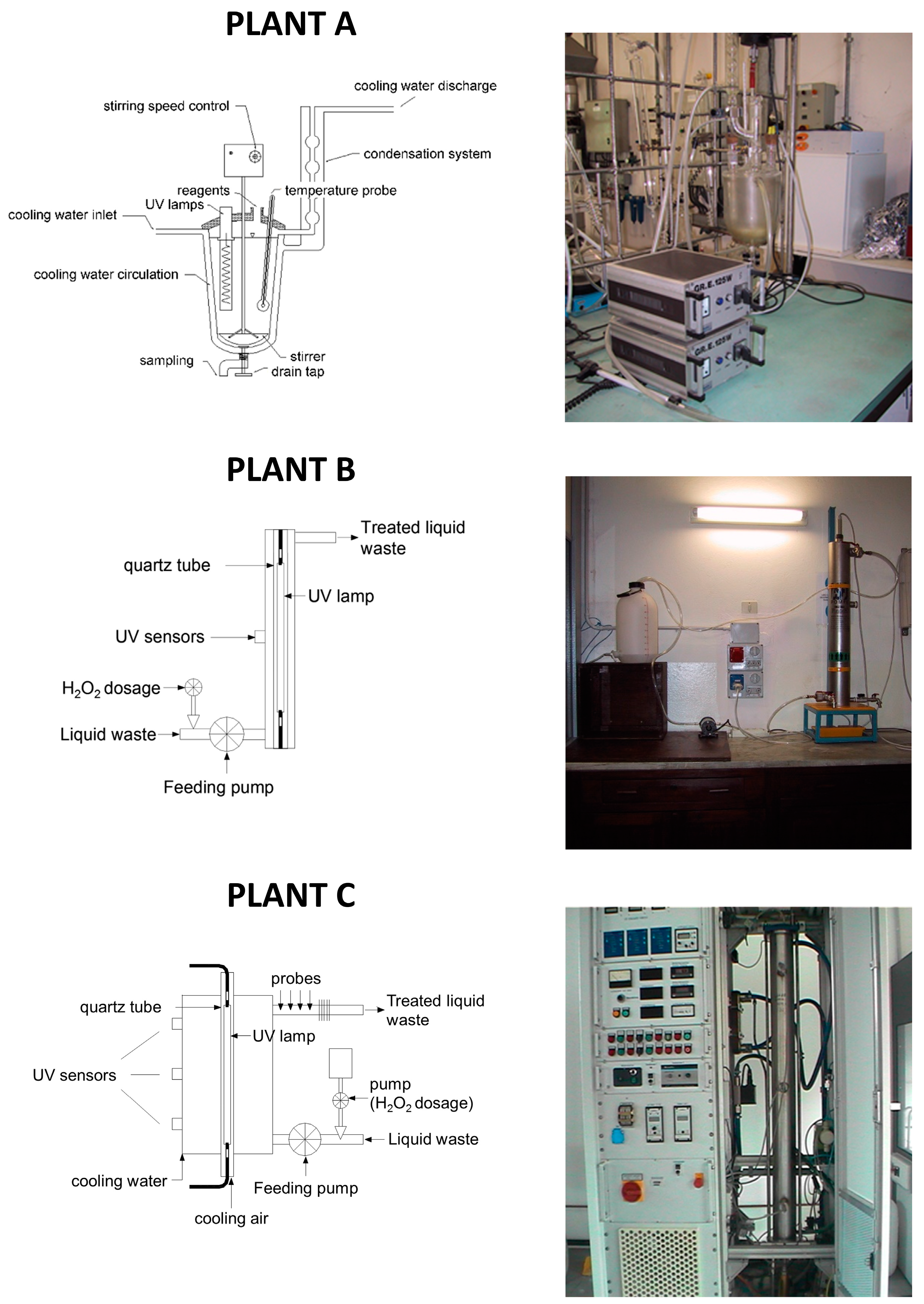

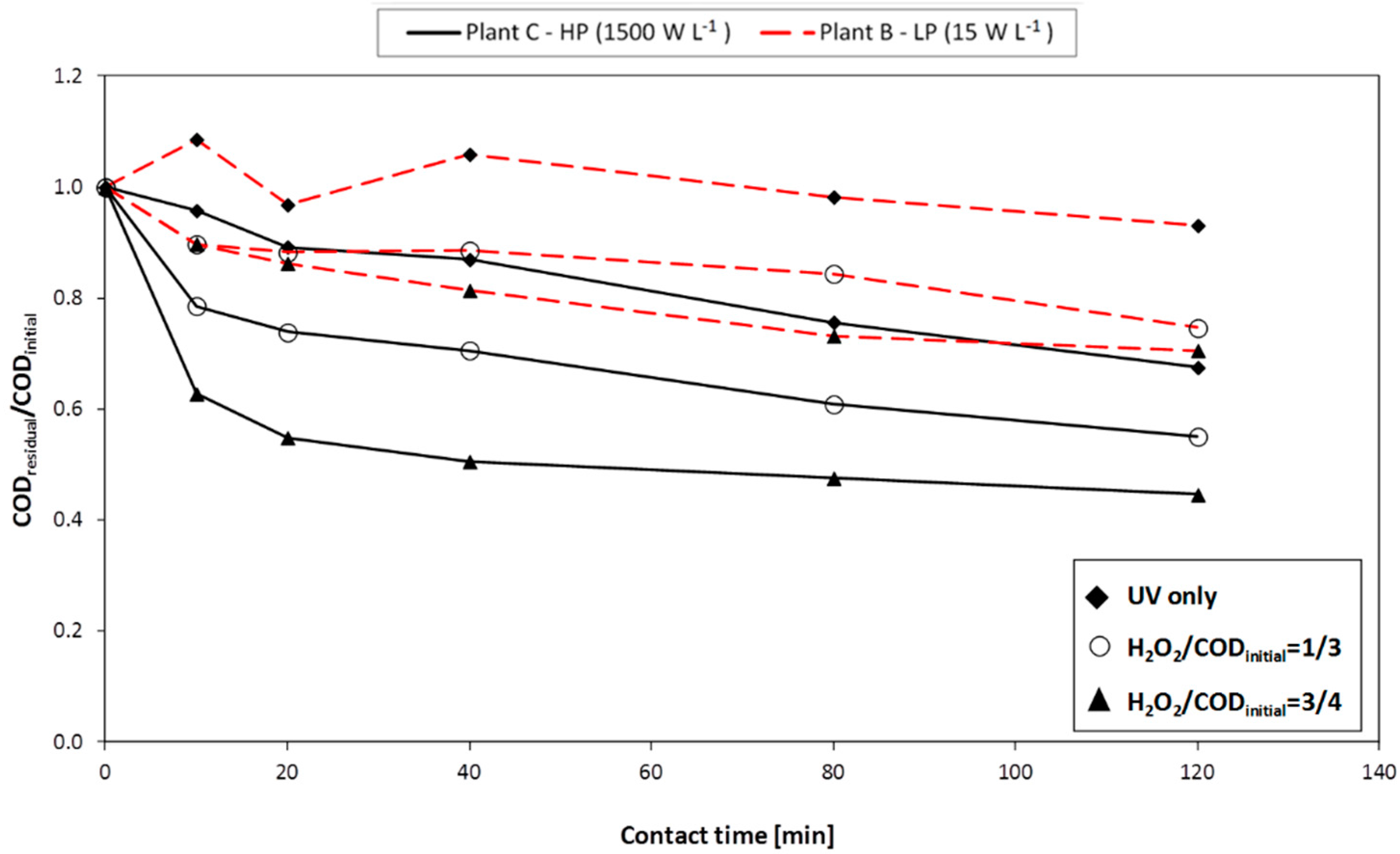
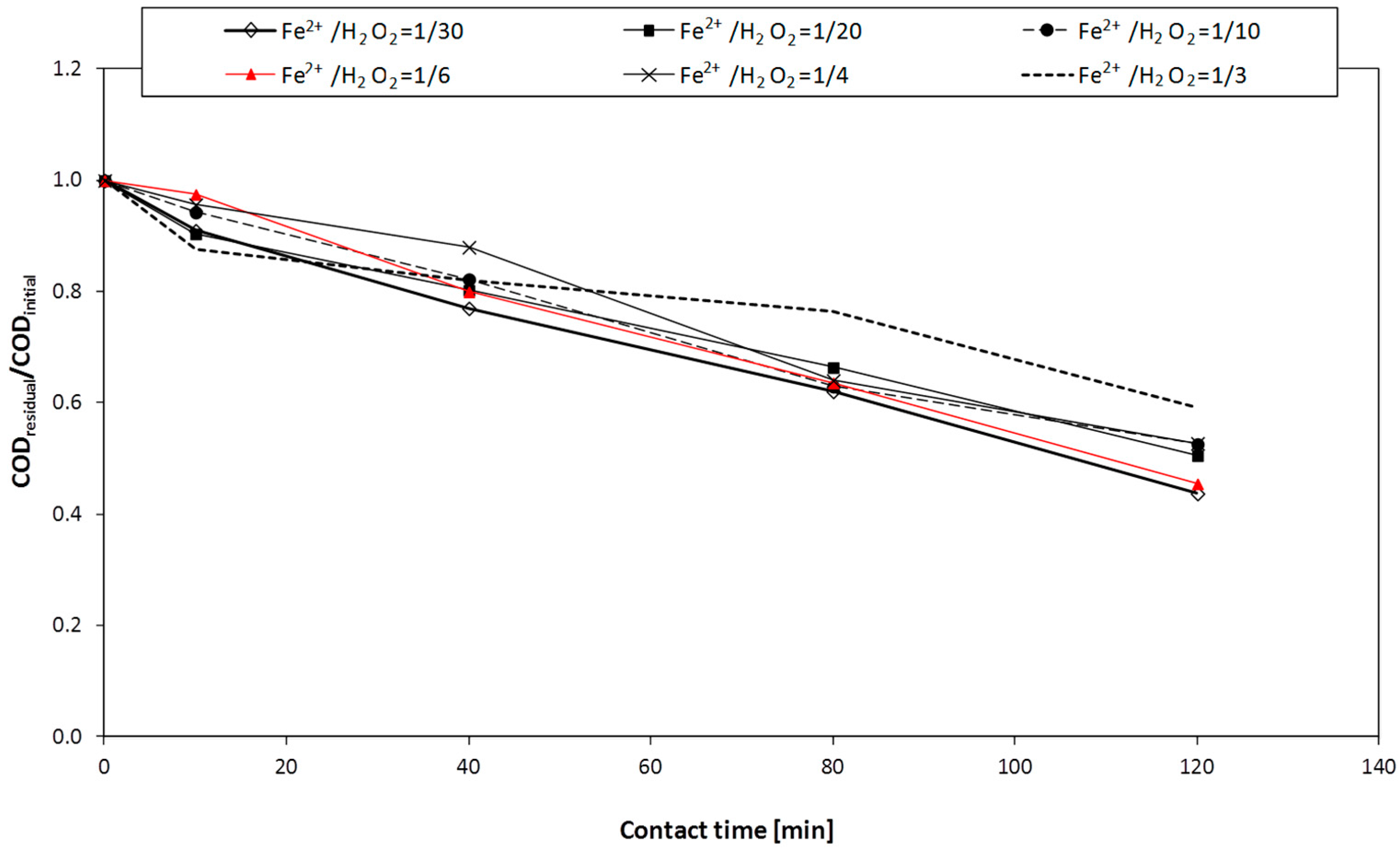
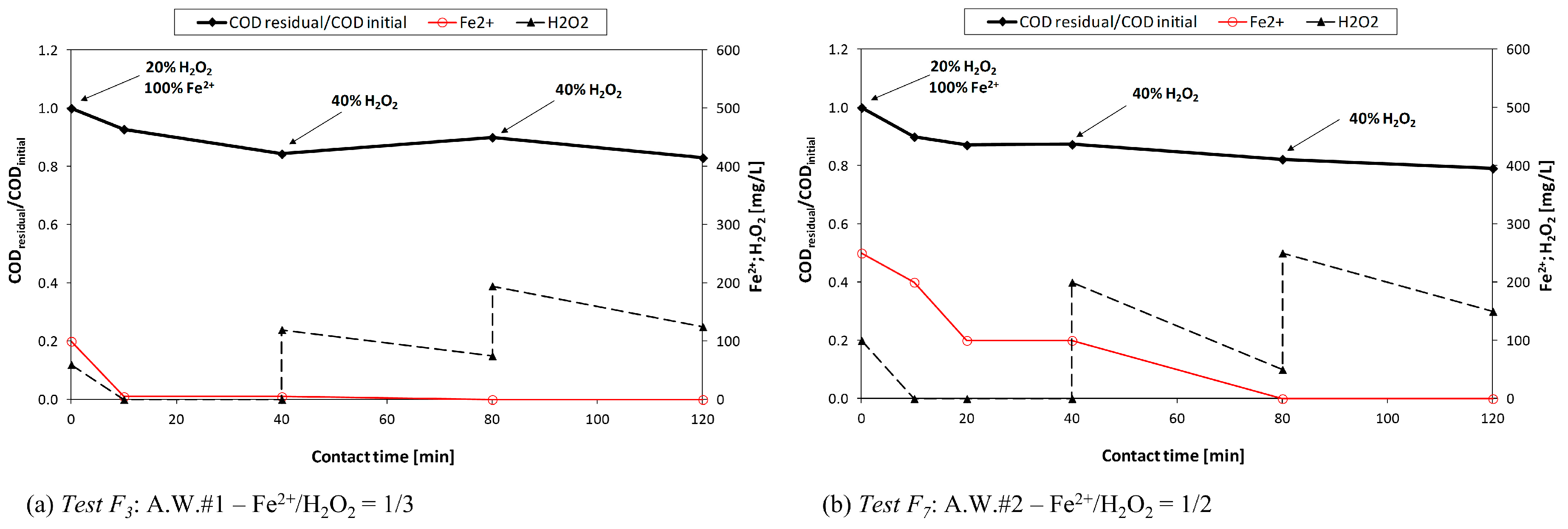
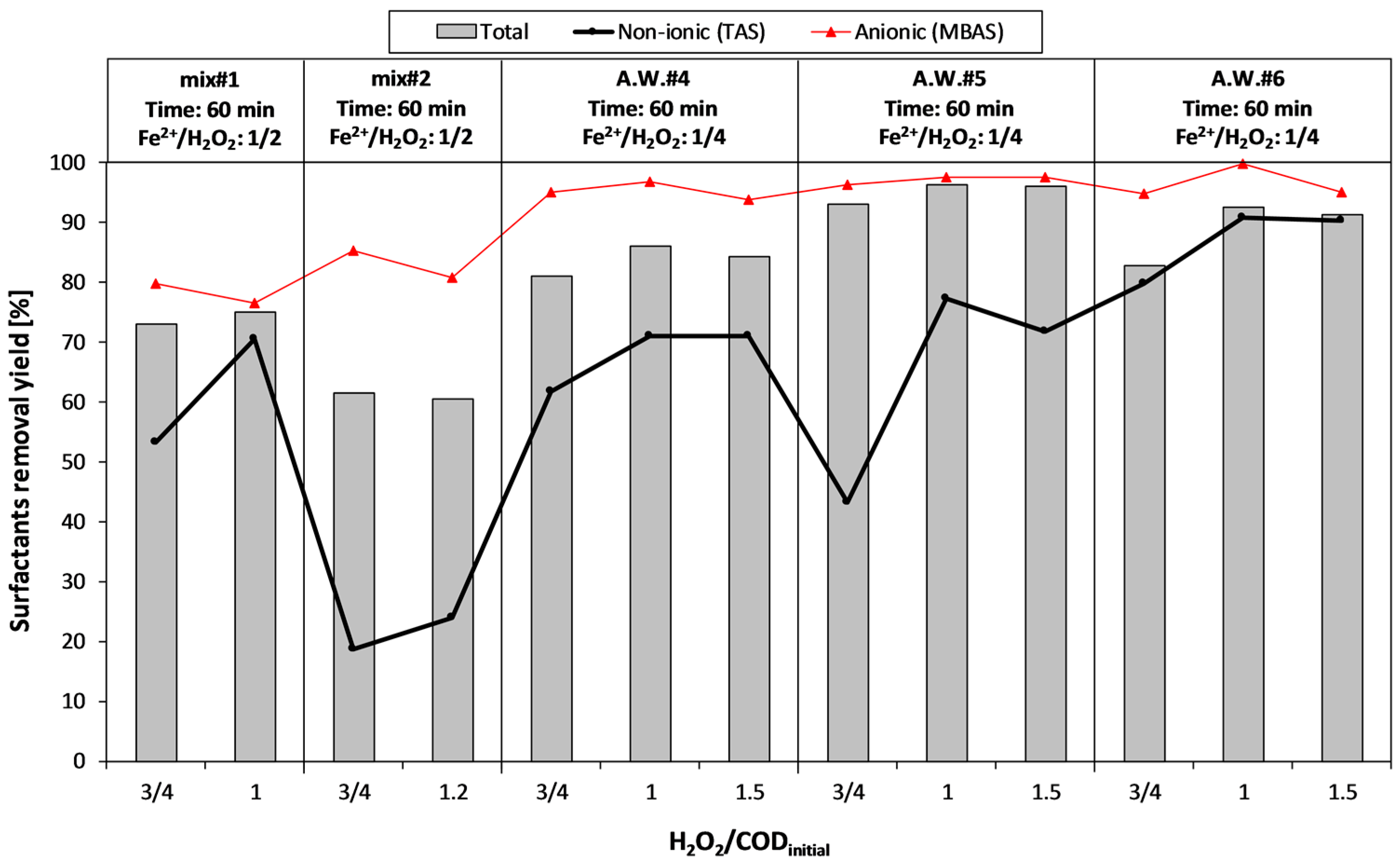
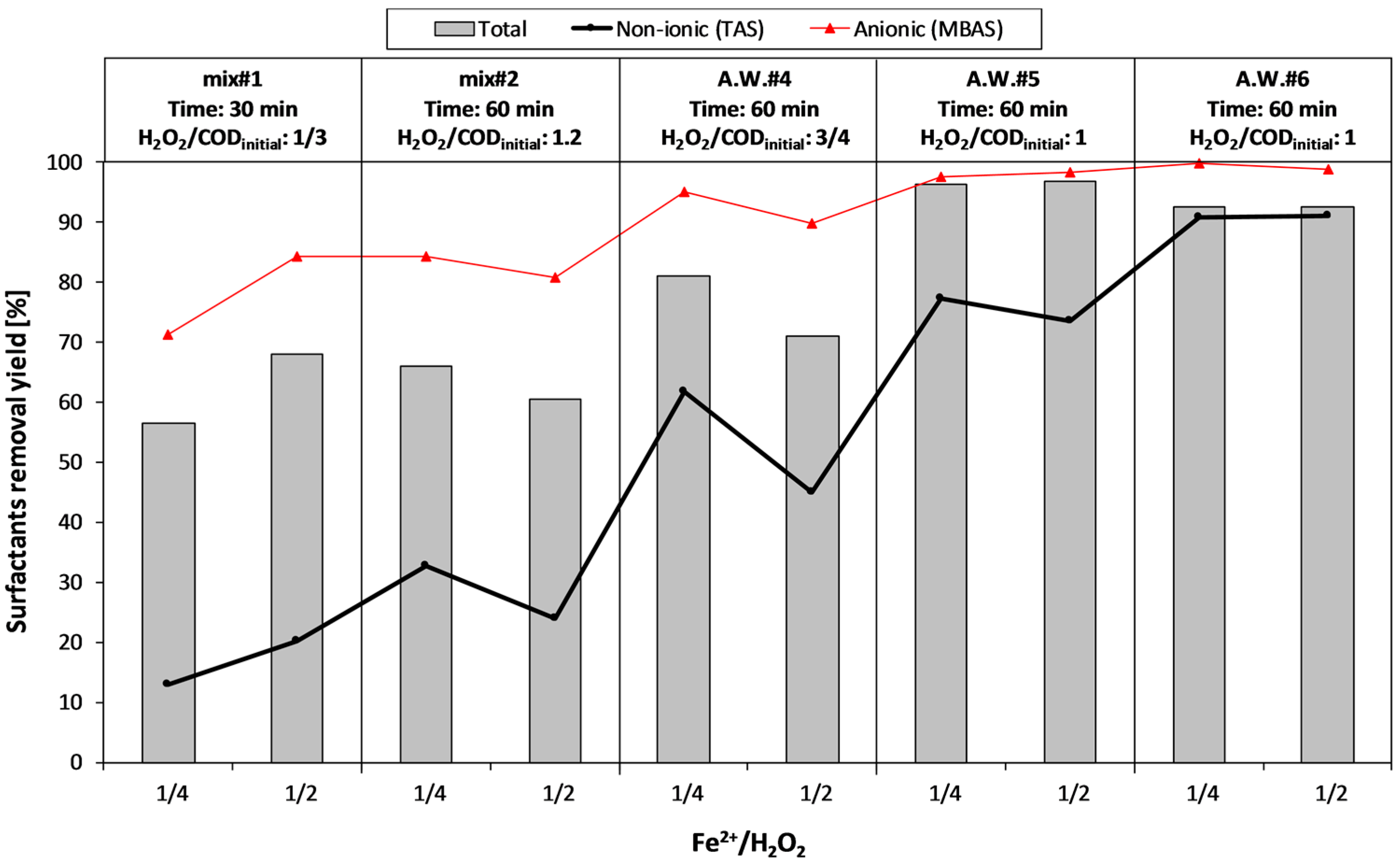
| Parameter | Phase I—COD Removal | Phase II—Surfactant Removal | |||||
|---|---|---|---|---|---|---|---|
| A.W.#1 | A.W.#2 | A.W.#3 | A.W.#4 | A.W.#5 | A.W.#6 | ||
| pH | - | 5.2–5.4 | 5.6–5.7 | 6.5–6.7 | 5.6–5.9 | 5.2–5.5 | 8.1–8.6 |
| COD | mg·L−1 | 200,000–220,000 | 95,000–100,000 | 18,000–20,000 | 55,000–56,600 | 48,000–50,000 | 98,000–104,000 |
| BOD5/COD | - | 0.48–0.50 | 0.38–0.41 | 0.42–0.45 | 0.18–0.25 | n.a. | n.a. |
| TN | mg·L−1 | <0.5 | 3800–4000 | 290–310 | <0.5 | <0.5 | <0.5 |
| N-NH4+ | mg·L−1 | <0.5 | 20–25 | 35–40 | <0.5 | 7–10 | 60–70 |
| N-NO3- | mg·L−1 | <0.5 | <0.5 | 15–20 | <0.5 | <0.5 | <0.5 |
| N-NO2- | mg·L−1 | <0.1 | <0.1 | 0.15–0.2 | <0.1 | <0.1 | <0.1 |
| TP | mg·L−1 | <0.5 | <0.5 | 380–420 | <0.5 | <0.5 | <0.5 |
| TAS | mg·L−1 | n.a. | n.a. | 20–25 | 980–1020 | 850–950 | 15,000–17,000 |
| MBAS | mg·L−1 | n.a. | n.a. | 95–110 | 1490 | 11,000–13,000 | 3500–3800 |
| Process Tested | Contact Time (min) | H2O2 Dosage | Fe2+ Dosage | UV | Air Supply | Aqueous Waste Tested | |||||
|---|---|---|---|---|---|---|---|---|---|---|---|
| (mg·L−1) | H2O2/CODinitial | Dosing Mode | (mg·L−1) | Fe2+/H2O2 | Dosing Mode | UV Plant | Lamp Power (W·L−1) | ||||
| H2O2/UV | 120 | 150 | 1/4 | Initial | - | - | - | A-MHP | 125 | No | A.W.#1 |
| 120 | 360 | 1/2 | Initial | 125 | |||||||
| 120 | 400 | 2/3 | Initial | 125 | |||||||
| 120 | 150 | 1/4 | Consecutive | 125 | |||||||
| 120 | 300 | 1/2 | Consecutive | 125 | |||||||
| 240 | 160 | 1/4 | Initial | 125 | |||||||
| 240 | 300 | 1/2 | Initial | 125 | |||||||
| 240 | 400 | 2/3 | Initial | 125 | |||||||
| 240 | 300 | 1/2 | Initial | 62.5 | |||||||
| 120 | 30 | 1/20 | Initial | - | - | - | B-LP | 4.5 | |||
| 60 | 1/10 | Initial | |||||||||
| 300 | 1/2 | Initial | |||||||||
| 120 | - | - | - | - | - | - | C-HP | 1500 | No | A.W.#2 | |
| 100 | 1/10 | Initial | 1500 | No | |||||||
| 200 | 1/5 | Initial | 1500 | No | |||||||
| 350 | 1/3 | Initial | 1500 | No | |||||||
| 500 | 1/2 | Initial | 1500 | No | |||||||
| 700 | 3/4 | Initial | 1500 | No | |||||||
| 700 | 3/4 | Continuous | 1500 | No | |||||||
| 1800 | 3/2 | Continuous | 1500 | No | |||||||
| 2250 | 5/2 | Continuous | 2000 | No | |||||||
| 700 | 3/4 | Initial | 1500 | Yes | |||||||
| 700 | 3/4 | Continuous | 1500 | Yes | |||||||
| 120 | - | - | - | - | - | - | B-LP | 15 | No | ||
| 350 | 1/3 | Initial | |||||||||
| 700 | 3/4 | Initial | |||||||||
| 350 | 1/3 | Initial | |||||||||
| 700 | 3/4 | Continuous | |||||||||
| Photo-Fenton | 120 | 300 | 1/2 | Consecutive | 10 | 1/30 | Initial | A-MHP | 125 | No | A.W.#1 |
| 240 | 10 | 1/30 | |||||||||
| 120 | 15 | 1/20 | |||||||||
| 120 | 25 | 1/10 | |||||||||
| 120 | 50 | 1/6 | |||||||||
| 120 | 67 | 1/4 | |||||||||
| 120 | 100 | 1/3 | |||||||||
| 120 | 60 | 1/10 | Consecutive | 10 | 1/6 | Initial | B-LP | 4.5 | |||
| 300 | 1/2 | 50 | 1/6 | ||||||||
| Fenton | 120 | 300 | 1/2 | Consecutive | 15 | 1/20 | Initial | - | - | No | A.W.#1 |
| 50 | 1/6 | ||||||||||
| 100 | 1/3 | ||||||||||
| 120 | 500 | 1/2 | Consecutive | 50 | 1/10 | Initial | - | - | No | A.W.#2 | |
| Consecutive | 100 | 1/5 | Initial | No | |||||||
| Continuous | 100 | 1/5 | Initial | No | |||||||
| Consecutive | 100 | 1/5 | Initial | Yes | |||||||
| Consecutive | 180 | 1/3 | Initial | No | |||||||
| Consecutive | 250 | 1/2 | Initial | No | |||||||
| Consecutive | 250 | 1/2 | Consecutive | No | |||||||
| Consecutive | 500 | 1 | Consecutive | No | |||||||
| Process Tested | Contact Time (min) | H2O2 Dosage | Fe2+ Dosage | Air Supply | Aqueous Waste Tested | ||||
|---|---|---|---|---|---|---|---|---|---|
| (mg·L−1) | H2O2/CODinitial | Dosing Mode | (mg·L−1) | Fe2+/H2O2 | Dosing Mode | ||||
| Fenton | 30 | 3600 | 1/3 | Initial | 1800 | 1/2 | Initial | No | A.W.#3 |
| 30 | 3600 | 1/3 | 900 | 1/4 | |||||
| 30 | 8200 | 3/4 | 1650 | 1/5 | |||||
| 60 | 11,000 | 1 | 5500 | 1/2 | |||||
| 60 | 8200 | 3/4 | 4100 | 1/2 | |||||
| 60 | 10,500 | 3/4 | 5200 | 1/2 | |||||
| 60 | 16,800 | 1.2 | 8400 | 1/2 | |||||
| 60 | 16,800 | 1.2 | 4200 | 1/4 | |||||
| 60 | 21,000 | 3/4 | Initial | 5200 | 1/4 | Initial | No | A.W.#4 | |
| 60 | 28,000 | 1 | 7000 | 1/4 | |||||
| 60 | 21,000 | 3/4 | 10,500 | 1/2 | |||||
| 30 | 21,000 | 3/4 | 5200 | 1/4 | |||||
| 60 | 42,000 | 3/2 | 10,500 | 1/4 | |||||
| 120 | 21,000 | 3/4 | 5200 | 1/4 | |||||
| 60 | 9400 | 3/4 | Initial | 2350 | 1/4 | Initial | No | A.W.#5 | |
| 60 | 12,500 | 1 | 3100 | 1/4 | |||||
| 60 | 18,700 | 3/2 | 4700 | 1/4 | |||||
| 30 | 9400 | 3/4 | 2350 | 1/4 | |||||
| 60 | 12,500 | 1 | 6250 | 1/2 | |||||
| 120 | 12,500 | 1 | 3100 | 1/4 | |||||
| 60 | 15,000 | 3/4 | Initial | 3750 | 1/4 | Initial | No | A.W.#6 | |
| 60 | 20,000 | 1 | 5000 | 1/4 | |||||
| 60 | 30,000 | 3/2 | 15,000 | 1/2 | |||||
| 30 | 15,000 | 3/4 | 3750 | 1/4 | |||||
| 60 | 20,000 | 1 | 5000 | 1/4 | |||||
| 120 | 20,000 | 1 | 5000 | 1/4 | |||||
| Time (min) | Photo-Fenton Test 1 (P-F1) | Photo-Fenton Test 2 (P-F2) | ||
|---|---|---|---|---|
| COD Removal Yield (%) | Residual H2O2 (mg·L−1) | COD Removal Yield (%) | Residual H2O2 (mg·L−1) | |
| 0 | - | - | - | - |
| 10 | 12 | 50 | 9 | 50 |
| 40 | 25 | 1 | 20 | 12.5 |
| 80 | 39 | 0 | 40 | 0 |
| 120 | 58 | 0 | 62 | 0 |
| 160 | - | - | 61 | 0 |
| 200 | - | - | 65 | 0 |
| 240 | - | - | 72 | 0 |
| Fenton Test | Aqueous Waste Tested | Iron Dosage (Fe2+/H2O2) | COD Removal Yield (%) |
|---|---|---|---|
| F1 | A.W.#1 | 1/20 | 10 |
| F2 | 1/6 | 11 | |
| F3 | 1/3 | 17 | |
| F4 | A.W.#2 | 1/10 | 3 |
| F5 | 1/5 | 11 | |
| F6 | 1/3 | 16 | |
| F7 | 1/2 | 21 |
| Aqueous Waste Tested | Iron Dosage (Fe2+/H2O2) | H2O2 Dosage (H2O2/CODinitial) | Contact Time (min) | Removal Yield (%) | ||
|---|---|---|---|---|---|---|
| TAS | MBAS | Total Surfactants | ||||
| Mix#1 | 1/5 | 3/4 | 30 | 52 | 76 | 70 |
| 1/2 | 60 | 53 | 80 | 73 | ||
| A.W.#4 | 1/4 | 3/4 | 30 | 44 | 90 | 71 |
| 60 | 62 | 95 | 81 | |||
| 120 | 83 | 99 | 92 | |||
| A.W.#5 | 1/4 | 3/4 | 30 | 70 | 97 | 95 |
| 60 | 43 | 96 | 93 | |||
| 1 | 60 | 77 | 98 | 96 | ||
| 120 | 76 | 98 | 97 | |||
| A.W.#6 | 1/4 | 3/4 | 30 | 89 | 94 | 90 |
| 60 | 80 | 95 | 83 | |||
| 1 | 60 | 91 | 99 | 93 | ||
| 120 | 91 | 98 | 92 | |||
© 2017 by the authors. Licensee MDPI, Basel, Switzerland. This article is an open access article distributed under the terms and conditions of the Creative Commons Attribution (CC BY) license ( http://creativecommons.org/licenses/by/4.0/).
Share and Cite
Collivignarelli, M.C.; Pedrazzani, R.; Sorlini, S.; Abbà, A.; Bertanza, G. H2O2 Based Oxidation Processes for the Treatment of Real High Strength Aqueous Wastes. Sustainability 2017, 9, 244. https://doi.org/10.3390/su9020244
Collivignarelli MC, Pedrazzani R, Sorlini S, Abbà A, Bertanza G. H2O2 Based Oxidation Processes for the Treatment of Real High Strength Aqueous Wastes. Sustainability. 2017; 9(2):244. https://doi.org/10.3390/su9020244
Chicago/Turabian StyleCollivignarelli, Maria Cristina, Roberta Pedrazzani, Sabrina Sorlini, Alessandro Abbà, and Giorgio Bertanza. 2017. "H2O2 Based Oxidation Processes for the Treatment of Real High Strength Aqueous Wastes" Sustainability 9, no. 2: 244. https://doi.org/10.3390/su9020244
APA StyleCollivignarelli, M. C., Pedrazzani, R., Sorlini, S., Abbà, A., & Bertanza, G. (2017). H2O2 Based Oxidation Processes for the Treatment of Real High Strength Aqueous Wastes. Sustainability, 9(2), 244. https://doi.org/10.3390/su9020244









